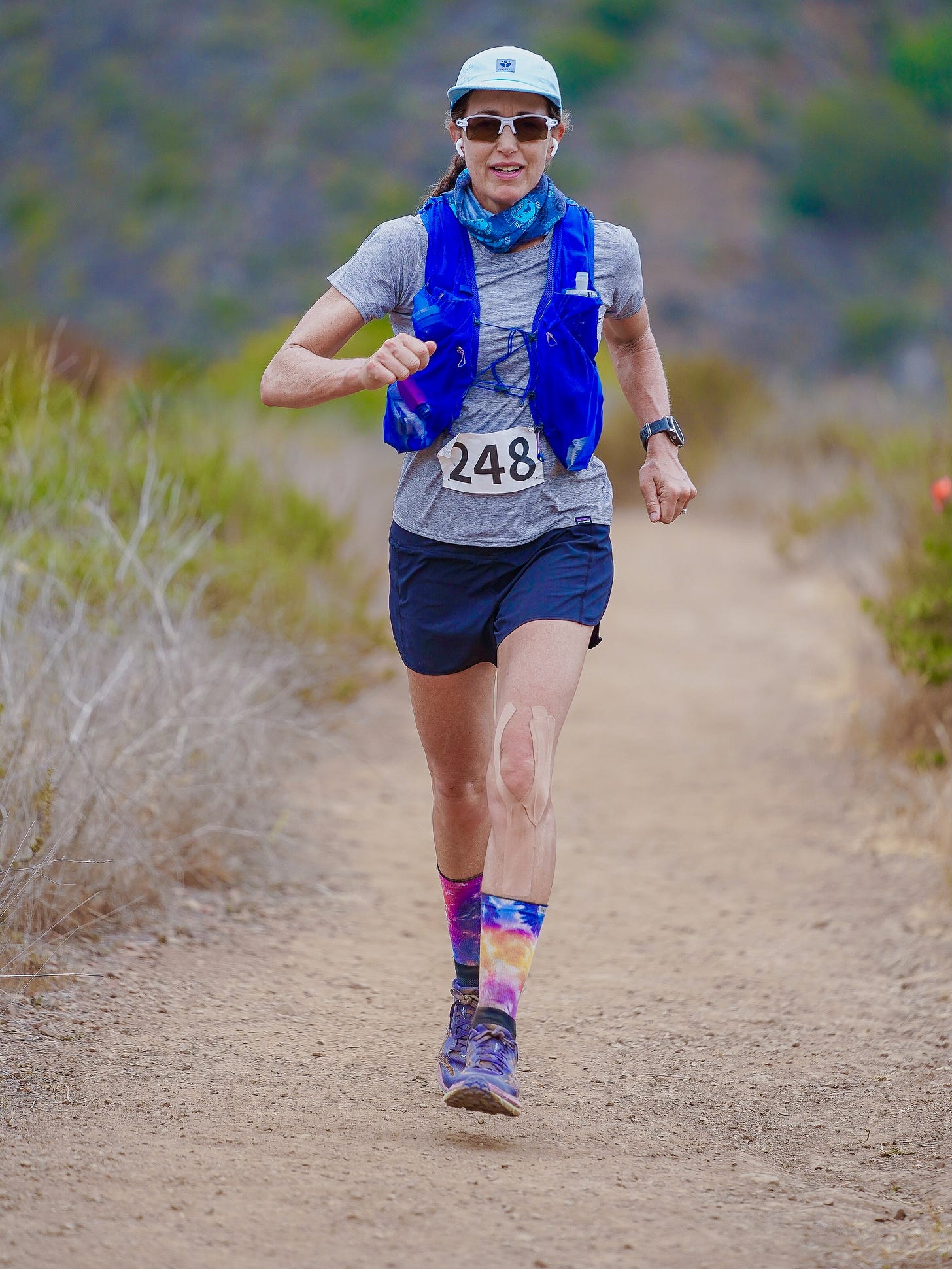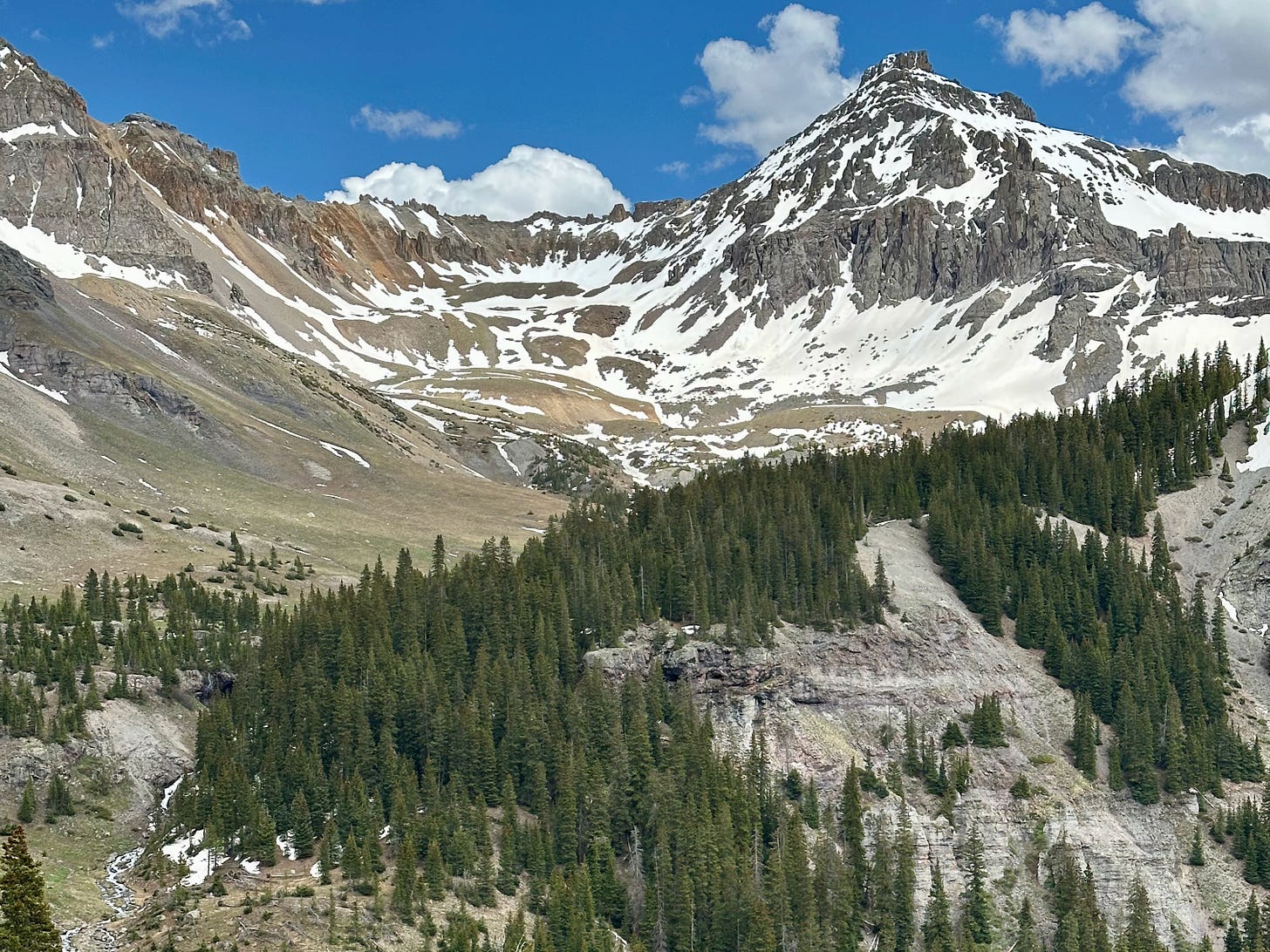This week’s post will be shorter because I’m pressed for time and energy while devoting more trail time to peak in training for the Hardrock Hundred, which is a little over four weeks away. I intend to have the metaphorical hay in the barn for training after this week, then run a 50-miler on June 21 as a dress rehearsal and final long effort, then cut training volume by more than half and endeavor to stay healthy in the remaining three weeks.
I know the date of the big goal is approaching because I’m processing “can’t get there” stress dreams. I’m late to the starting line because I forgot the race starts on Friday not Saturday, so I frantically drive from Telluride to Silverton, but the highway drops off into a massive rocky gorge. I’m organizing a mess of clothing and gear into drop bags that are giant suitcases—too big for the aid station to allow—and I don’t know what goes where. I’m starting the run and realize I forgot to feed the horses, so I stop to call home to remind my husband—while all the other runners get ahead—but I can’t make the buttons on my phone (an old Motorola, not my iPhone) work. They’re classic stress dreams that feel anxiety-ridden in the middle of the night but seem funny in the morning.
I’ll share just one other anecdote this week, but first I want to mention that tomorrow (Thursday, June 12) at 5 p.m. Mountain, I’ll host the monthly Zoom for paid subscribers. This one will feature a Q&A with special guest Kylee Van Horn, RDN, the sports nutritionist who has been helping me for several months. If you’d like an invitation to this monthly meetup plus occasional bonus posts, please upgrade your subscription to the supporter level. I’d greatly appreciate your support!
Speaking of Kylee, I strongly recommend the podcast she co-hosts, “Your Diet Sucks,” for well-researched nutrition advice that breaks down and calls B.S. on many nutrition trends and wellness fads.
How to handle the slowdown
While in Southern California last weekend, I ran a 50K in the hills north of Malibu. I did not intend to race it but rather treat it as a long supported training run, my goals being to finish uninjured and feeling relatively fresh, to practice fueling and hydration, and to stay positive mentally. I didn’t want to give it my top effort and end fully depleted because I faced a big-volume training plan this week.
The trail route was so smooth and runnable, and comparatively easy at oxygen-rich sea level with cool foggy air, that I ended up running far more steadily and faster than I ever do here in the rugged high-altitude San Juan Mountains, even though this coastal route had four major climbs with around 4700 feet total elevation gain. The route made me feel like a legit runner again—as opposed to a trekker who hikes as much as runs in the mountains—and I finished in a respectable time of 6 hours, 31 minutes, feeling happy and grateful that I could still run a 50K and finish in the top half of the pack.

After the finish, I stood and chatted with an old friend who had finished a little ways ahead of me. He had a rough run and sounded more discouraged than happy. Tentatively, as if broaching a touchy subject, he recalled when we met in the early 2010s and regularly ran 50Ks in the low to mid five-hour range, not well over six hours as we did Saturday. Now in his late forties, he asked, “How do you handle it, the slowdown with aging? It’s real.”
I gave him a couple of pat replies, mentioning I don’t really care how I place or rank in the sport anymore because I’m so checked out from following the frontrunners. I also gave the standard “it’s all relative” answer and told him how two days prior, I went to a track near my in-laws’ house and knocked off a mile in 7:50, which felt fun and fast since I rarely break an 8 or even 9 minute pace in the Colorado mountains. I didn’t let myself dwell on the fact I used to run track intervals at a 6-minute pace; I just felt joy that I could crank out a sub-8 mile, and it felt “fast” even though fifteen years earlier it would have felt quite “slow.”
After we parted, I realized my answers weren’t very satisfying. If I had given it more thought, I would have also told him this:
I would have said, “It’s so great to see you here! You showed up, as did I, and that’s what really matters.” Continuing to show up and participate at whatever speed and distance you can is a manifestation of longevity in the sport and the key to being part of a community.
If your ego feels bruised by your finish time, it helps to remember that there always will be countless faster runners ahead, just as there always will be slower ones behind. Unless you’re an elite-level competitor, nobody but you pays much attention to your time or actually cares about it—they’re just glad to see you there.
Your presence also serves as a role model for younger runners. Personally, I’m deeply grateful for the small but mighty group of sixtysomething female runners who continue to participate in ultras and help me believe I can keep going in this sport in the next decade and beyond. I like to think I’m filling that role in the eyes of younger female runners. (On a related note, kudos to Andy Jones-Wilkins for focusing on the six over-70 runners in his latest column on intriguing storylines in the upcoming Western States Endurance Run.)
Recently, I started showing up again to a weekly group run here in Telluride that intimidates me, because all of the runners are much younger and faster—I’m old enough to be their mom. Their easy conversational pace feels like a tempo-to-5K pace for me. Then it hit me: I don’t have to keep up. I can do my own thing, run my own pace; if they get ahead, that’s OK. I told them not to wait for me at trail intersections, because I know the way; I just want to start with them and enjoy the conversation at the beginnings and ends of the runs. By taking the pressure off myself to keep up with them, I could enjoy it.
A funny thing happened: everyone was so welcoming and glad to see me. As the self-appointed “caboose” who would bring up the end, I made it OK for other runners to run slower. One or two ran toward the back with me. The group is becoming more inclusive pace-wise because of it.
I should have advised my friend last Saturday to take the pressure off himself to run the way he did a decade ago, along with the pressure to keep up with the pack. Just run however feels best now. Just run.




All of this! And as one of those 60ish women you speak of I am just so grateful that my body can still let me do this! And in my tough 50 miler last weekend I was the oldest female finisher and no one cared about my pace except me in that I finished an hour before cutoff 💪💪💪
Hi Sarah,
Very well written for us older folks.
I read Mountain Running to be inspired by your mental toughness over long distances
Times rate lower on the list these days.
I keep motivated by thinking....
.....If there were no races, I'd still run.
....If there were not GPS watches, I'd still run.
....If I were the last human on earth, I'd still run.
And work backwards from there.